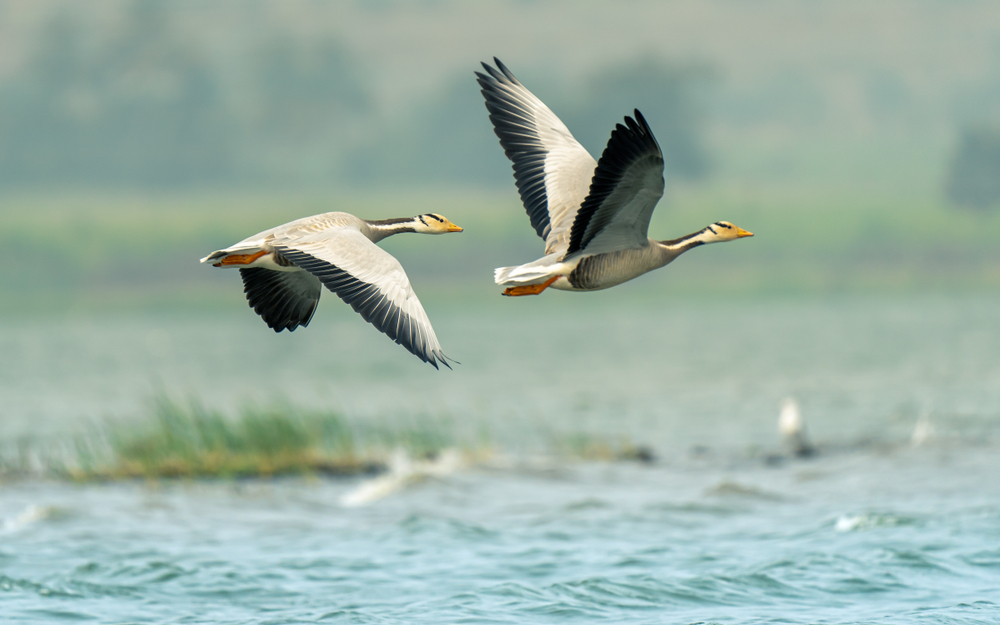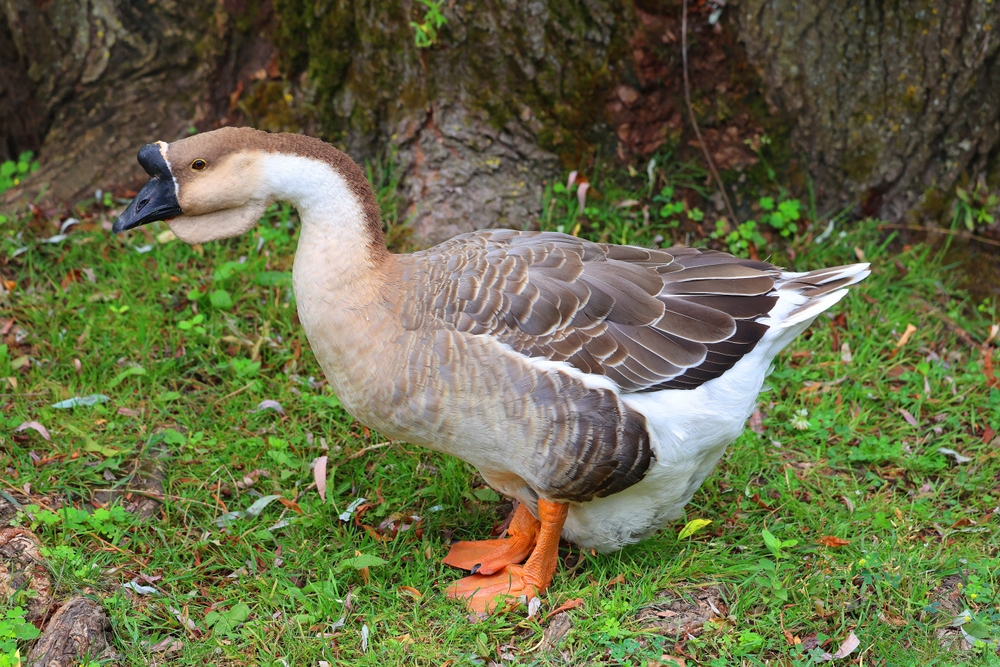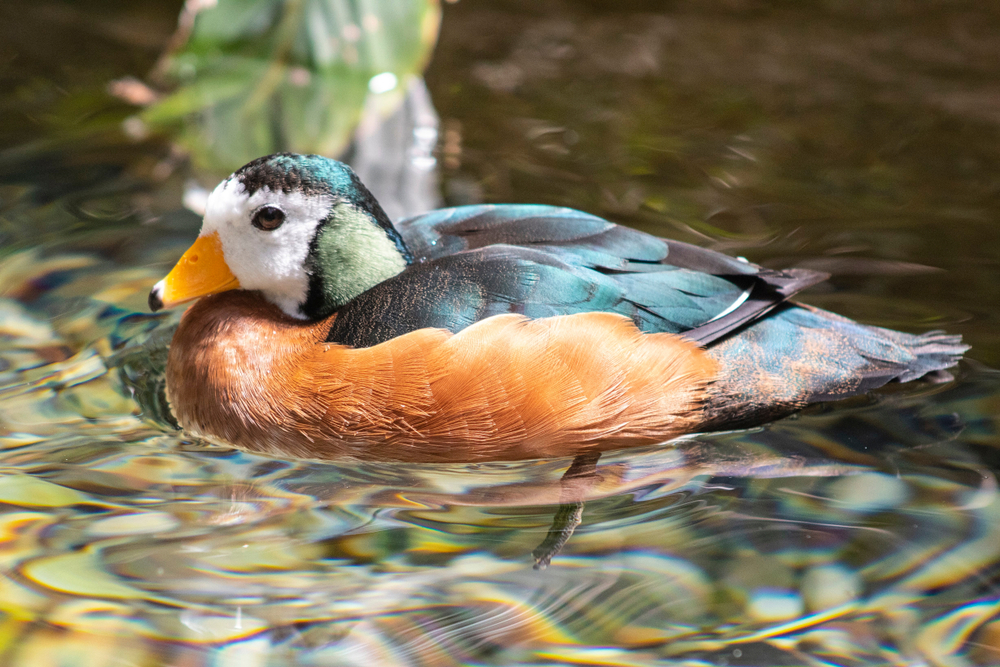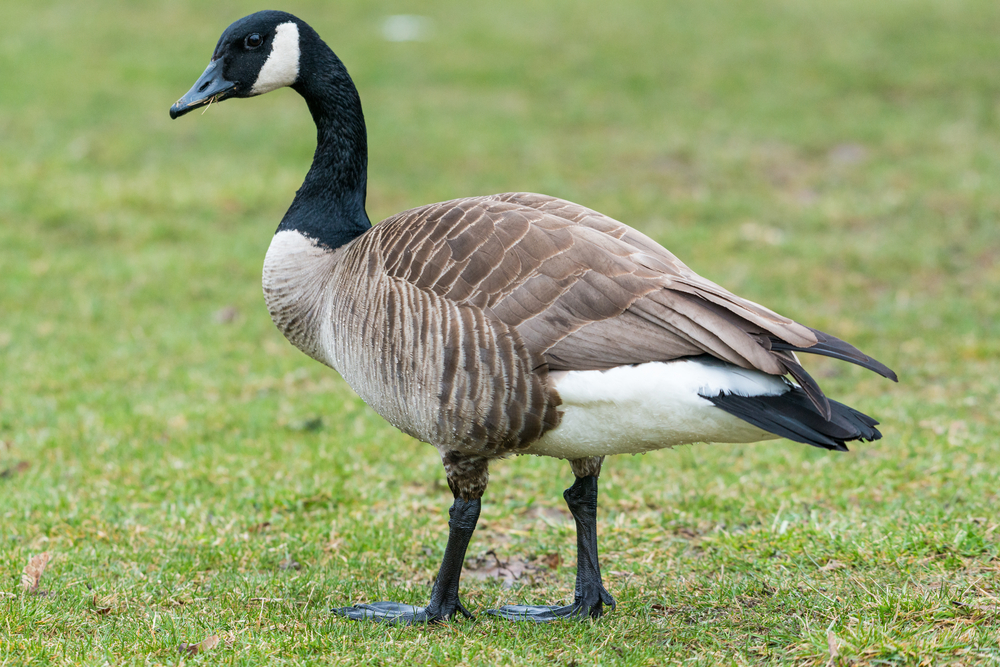Its closest relative is the Swan Goose (Anser cygnoides), with which it shares genetic similarities. Both belong to the genus Anser, along with other gray geese such as the Greylag Goose (Anser anser).
About
The Bar-headed Goose (Anser indicus) is a remarkable waterfowl in the Anatidae family, famous for its record-breaking high-altitude migrations. Native to Central Asia, it breeds around high-altitude lakes in Mongolia, Tibet, and western China, and migrates south across the Himalayas to wintering grounds in India, Bangladesh, and Myanmar. During this journey, it has been recorded flying at altitudes of more than 7,000 meters (23,000 feet), making it one of the highest-flying birds in the world.
This medium-sized goose measures 71 to 76 centimeters (28 to 30 inches) in length, with a wingspan of 140 to 160 centimeters (55 to 63 inches). It is easily recognized by its pale gray plumage, orange legs, and the two distinctive black bars across the back of its white head, which give the species its name. Both sexes look alike, though males are slightly larger.
Bar-headed Geese are primarily herbivorous, feeding on grasses, grains, and aquatic plants. During migration, they often forage in agricultural fields, feeding on rice and wheat, which can sometimes bring them into conflict with farmers. Despite this, they play an important role in grassland ecosystems, aiding seed dispersal and nutrient cycling.
Breeding occurs in colonies near high-altitude lakes, where nests are built on the ground, often on islets or cliff ledges for protection. Females typically lay four to six eggs, and both parents care for the goslings, which must quickly adapt to harsh mountain conditions.
The species is currently listed as Least Concern, with a stable population, though it faces threats from habitat loss, hunting, and agricultural conflicts. Its resilience, endurance, and extraordinary migratory feats have made it a subject of scientific study and admiration.
The Bar-headed Goose stands as a symbol of adaptation and endurance, embodying the ability of life to thrive in some of the planet’s most extreme conditions.
Physical Characteristics
The Bar-headed Goose is a striking, medium-sized goose, best known for its incredible high-altitude migrations across the Himalayas.
Plumage: The overall plumage is pale gray, with a lighter whitish underside. The head is white, marked by two bold black bars across the back of the crown and nape, which give the species its name. The upperwings are light gray with contrasting darker flight feathers, while the tail is tipped in black.
Head & Beak: The head is white with the distinctive black bars, and the beak is short, strong, and orange-yellow in color. The eyes are dark brown, surrounded by a narrow pale orbital ring.
Body & Wings: The body is slender but powerful, with a long neck suited for grazing and alert scanning. Wings are long and pointed, adapted for sustained high-altitude flight. Legs and feet are orange, strong, and webbed, designed for both swimming and walking on grasslands.
Size:
-
Length (Body and Tail): 28–30 in (71–76 cm)
-
Wingspan: 55–61 in (140–155 cm)
-
Tail Length: 6–7 in (15–18 cm)
Weight:
-
Adult Male: 5.5–7.7 lbs (2.5–3.5 kg)
-
Adult Female: 4.4–6.6 lbs (2–3 kg)
The Bar-headed Goose’s light gray body, white head with black bars, and bright orange bill and legs make it instantly recognizable. Its specialized physiology allows it to fly at altitudes over 29,000 ft (8,800 m), making it the highest-flying bird in the world.
Reproduction
The reproductive cycle of the Bar-headed Goose is adapted to the extreme conditions of high-altitude lakes and plateaus in Central Asia.
1. Mating and Courtship:
Bar-headed Geese are monogamous, forming long-term pair bonds. Courtship displays include mutual calling, synchronized swimming, and head-dipping. Once paired, they remain together year after year.
2. Breeding Season:
Breeding occurs during the summer months (May–July), immediately after their arrival at high-altitude nesting grounds following spring migration.
3. Nesting:
Nests are built on the ground near lakes, rivers, or marshes, often in open, exposed areas. They are simple scrapes lined with grass, feathers, and down plucked from the female.
4. Egg Laying and Incubation:
The female lays 3–8 eggs, usually pale white. She incubates the eggs for 27–30 days, while the male remains nearby to guard the nesting site.
5. Hatching and Chick Development:
Chicks are precocial, covered in down and able to walk within hours of hatching. Parents lead them to water soon after birth, where they begin feeding on aquatic plants and insects. Both parents protect and guide the goslings.
6. Fledging:
The young fledge at about 8–9 weeks, but remain with the family group during migration, learning flight paths and feeding strategies.
7. Sexual Maturity:
Bar-headed Geese typically reach breeding maturity at 2–3 years of age, when they begin forming pairs and establishing territories.
The Bar-headed Goose’s breeding cycle is a race against time—nesting and raising chicks during the short summer at high altitudes before beginning its extraordinary migration across the Himalayas.
Lifespan
The Bar-headed Goose is a hardy and long-lived migratory species, with its survival shaped by the rigors of high-altitude breeding and long-distance migration.
Lifespan in the Wild:
In natural conditions, Bar-headed Geese live on average 15–20 years. Many young do not survive their first migration due to predation, harsh weather, or exhaustion, but adults that establish territories and migrate successfully may live two decades or longer.
Lifespan in Captivity:
In zoos and waterfowl collections, with consistent food and veterinary care, individuals can live up to 25–30 years, free from the dangers of migration and predation.
Threats to the Bar-headed Goose:
-
Predation: Eggs and chicks are preyed upon by foxes, jackals, and birds of prey. Adults face threats from raptors during migration.
-
Hunting: In parts of their wintering range, they are hunted for food.
-
Habitat Loss: Wetland drainage and human disturbance reduce breeding and feeding sites.
-
Migration Risks: Their high-altitude flights expose them to extreme weather, low oxygen, and long distances that test their endurance.
Conservation Status:
The species is currently listed as of Least Concern by the IUCN, thanks to its wide distribution and stable populations, though local declines occur due to hunting and wetland degradation.
Eating Habits
The Bar-headed Goose is a primarily herbivorous grazer, with a diet adapted to high-altitude wetlands and grasslands.
Diet:
They feed mainly on grasses, sedges, shoots, leaves, and seeds. During migration and in wintering grounds, they also consume cultivated grains such as barley, wheat, and rice, often foraging in harvested fields. Aquatic plants, algae, and small invertebrates may supplement their diet.
Foraging Strategy:
Bar-headed Geese are ground feeders, grazing in flocks on grasslands, pastures, and agricultural fields. Their short, strong bills are adapted for clipping grasses and pulling up roots. In wetlands, they dabble and graze on aquatic vegetation.
Feeding Behavior:
They feed in family groups or large flocks, especially outside the breeding season. Their highly social feeding habits provide protection from predators through collective vigilance.
Migration and Feeding:
During their long migrations, they stop at key wetlands to replenish energy reserves, consuming nutrient-rich grasses and grains to fuel their high-altitude flights.
Feeding Young:
Goslings graze alongside their parents within hours of hatching, feeding on tender grasses and small aquatic plants. Parents guide them to safe and food-rich areas but do not directly feed them.
Seasonal Feeding:
In summer, at high-altitude breeding grounds, their diet is dominated by fresh grasses and sedges. In wintering areas across South Asia, they shift to grains, harvested crop residues, and green shoots in farmlands.
The Bar-headed Goose’s flexible diet allows it to thrive in both wild wetlands and agricultural landscapes, providing the fuel necessary for its remarkable Himalayan migrations.
Uniqueness
The Bar-headed Goose is one of the most extraordinary migratory birds in the world, known for its record-breaking flights and physiological adaptations:
Highest-Flying Bird: It holds the distinction of being the highest-flying bird species, regularly crossing the Himalayas at altitudes over 29,000 ft (8,800 m), where oxygen levels are less than a third of those at sea level.
Specialized Physiology: Adaptations for high-altitude flight include hemoglobin with unusually high oxygen affinity, enlarged lungs, and highly efficient muscle fibers that allow them to function in extreme hypoxia.
Migratory Endurance: They migrate thousands of miles each year from breeding grounds in Central Asia to wintering areas in South Asia, flying both day and night and covering vast distances without prolonged rest.
Striking Head Markings: Their white heads with two bold black bars across the crown and nape give them a unique appearance, instantly distinguishing them from other geese.
Social Behavior: Highly social, they travel in large flocks, often flying in V-formations to conserve energy during migration.
Cultural Importance: The Bar-headed Goose is mentioned in Tibetan and Indian folklore as a symbol of endurance and spiritual strength, admired for its ability to cross the “roof of the world.”
Resilience in Farming Landscapes: While wild by nature, they readily forage in agricultural fields during winter, demonstrating an adaptability that helps sustain their populations.
The Bar-headed Goose’s combination of incredible high-altitude endurance, unique physiology, and symbolic cultural role makes it one of the most remarkable and celebrated migratory waterfowl on Earth.
Be the First to Share Photos of This Species.
FAQ’s
1. What is the closest species to the Bar-headed Goose?
2. How does the Bar-headed Goose compare to other geese?
It is slightly smaller and slimmer than the Greylag Goose, with a more upright posture and distinctive black bars on the head. Unlike most geese, it is uniquely adapted for high-altitude flight, crossing the Himalayas at altitudes where few animals can survive.
3. What national parks provide the best opportunities to see a Bar-headed Goose?
What national parks provide the best opportunities to see a Bar-headed Goose?
-
Keoladeo National Park, India – A major wintering site for large flocks.
-
Kaziranga National Park, India – Commonly seen in wetlands during winter.
-
Chitwan National Park, Nepal – Regular winter visitor along riverbanks and lakes.
-
Ladakh Wetland Reserves, India – Breeding at high-altitude lakes like Tso Moriri.
-
Rara National Park, Nepal – Breeding population at Himalayan lakes.






































































